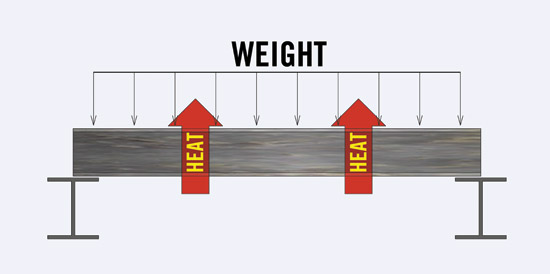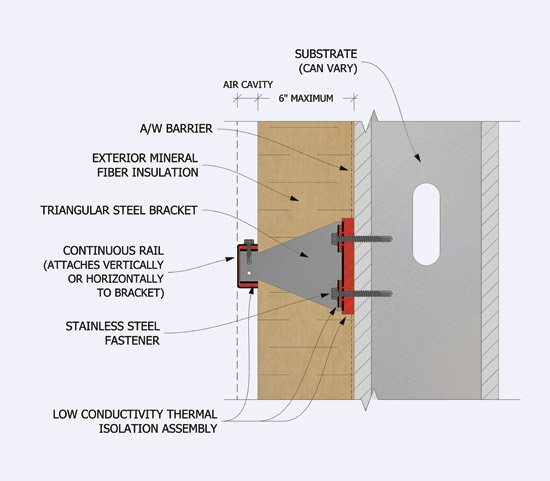Conforming to Code
The ASHRAE rating is primarily due to the steel studs penetrating the insulation, creating a bridge for heat to transfer. The insulation on its own is R-19, yet once it's made part of an assembly, the installation method will begin to affect it and ultimately create its effective R-value. Effective R-value is the inverse of the U-value for the entire wall assembly, which is commonly referenced within the code.
The same challenge of deteriorating insulating values can be seen on exterior insulated wall assemblies as well, where only a fraction of the insulation's stated R-value is actually delivered. As will be discussed later in detail, using a typical continuous furring channel for cladding attachment, such as a vertical Z-girt, will only allow the insulation to perform at ±40 percent of its rated R-value. Rotate the cladding attachment Z-girt 90 degrees to the horizontal and the effectiveness of the insulation will only be increased ±50 percent of its rated R-value. Consequently, the building owner, or occupant, is only receiving half of what they actually paid for.
 |
Steel has a small footprint, is non-combustible, and has excellent strength and structural properties. However, it has very poor thermal properties. Image courtesy of Knight Wall Systems |
There are several characteristics of the cladding attachment methodology and configuration that affect overall thermal performance and can cause thermal short circuits, which can drastically reduce the effectiveness of the insulation. There are three key culprits that affect the exterior insulation's clear wall performance—the amount of material penetrating the insulation, the actual conductivity of the material penetrating the insulation, and the amount of contact area between all bridged/connected parts.
Amount of material penetrating the insulation. With a greater cross-sectional area of material penetrating the insulation, a greater amount of heat energy can be moved. The best way to think of this is an eight-lane interstate versus a two-lane road with the cars analogous of the heat energy. Which one can move more cars (read heat energy) from point A to point B per hour? With material penetrating the insulation, the actual thermal conductivity of the material used for the attachment system will allow for more heat energy to be transferred.
Conductivity of material. It is important to note that every material in the world has the property of thermal conductivity, but some materials are very low in conductivity whereas others are very high. Aluminum has a far greater thermal conductivity than steel. Therefore, more heat energy will be able to flow through a cross section of aluminum versus steel, decreasing overall performance even further. Looking at the road and car analogy, aluminum is a 75-mph interstate whereas steel is a 35-mph street. Which way moves cars, or heat energy in this analogy, from point A to point B fastest?
Contact. How the material contacts the substrate and different pieces within the cladding attachment assembly also has an effect on how heat energy transfers. The greater the contact area between conductive materials, the more heat energy can transfer and move from point A to point B. If we limit contact area, we can “bottleneck” and limit the heat energy transfer. So looking at the road and car analogy one last time, reduction in contact area is like a traffic jam on a busy interstate. The cars (heat energy) are still moving from one point to another, but at a much slower rate since only a limited number of cars can get onto the road at once.
The Rainscreen Edge
One option to complying with code requirements is a properly deployed rainscreen, which is an exterior cladding infrastructure that sits away from a building's outside wall's weather-resistant barrier, creating an air cavity directly behind the cladding that helps to protect the building's important weather-resistant barrier. This allows any moisture that may pass by the cladding to easily drain away from the building, and the air that flows between the cladding and the wall due to convection accelerates evaporation of any residual moisture. A rainscreen should be viewed as a building envelope support mechanism, whose primary function is not to provide barrier protection against water penetration (such as a weather-resistant barrier does). Rather, a rainscreen is designed to limit the amount of water that could potentially come into contact with the primary building envelope's moisture barrier, thereby reducing the chance of water finding a way into the wall assembly. It does this by defending the wall assembly against the five forces that drive rain into buildings: kinetic energy, gravity, capillary action, surface tension, and pressure gradients.
Not all rainscreens are created equal, however, and how they are attached to the building envelope can make a significant difference. Two viable approaches to reducing thermal bridging are mineral fiber and rigid foam rainscreen systems. The former reduces thermal bridging via the use of thermally isolated steel brackets, and the latter by thermally isolated screw attachments through the rigid insulation where no metal penetrates the insulation except for the fasteners, thus meeting the definition of ci. Essentially accomplishing the same thing, these systems can be specified according to user preference. Rainscreen attachment methods used in conjunction with rigid foam are the most thermally efficient and the thinnest energy code compliant wall assemblies since there is so much less metal penetrating the exterior insulation. The thermally isolated steel brackets used in conjunction with mineral fiber systems is far more efficient than any other mineral fiber cladding attachment approach, including brackets made entirely of low conductive fiber reinforced polymers. Though the use of a bracket for attachment does not conform to the code definition of ci, it does meet code via the prescriptive U-factor.
 |
|
Image courtesy of Knight Wall Systems |
While the manner in which exterior insulation has been typically added to wall assemblies decreases the insulation's thermal performance by half, isolated steel brackets in rainscreen construction can result in increased insulation effectiveness, up to 90 percent over traditional methods. When only thermally isolated screw fasteners penetrate the insulation, 98 percent effectiveness can be achieved.









